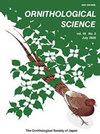孟加拉雌性芬奇对性信号的偏向性学习
IF 0.3
4区 生物学
Q4 ORNITHOLOGY
引用次数: 0
摘要
摘要配偶偏好学习的峰移可能是快速重复物种形成的驱动因素。因此,经过最近的适应性辐射的分支被预测会对来自异性的信号表现出有偏见的学习。雌雀就是这样一个分支。在包括斑马芬奇(Zebra Finch Taeniopygia guttata)和孟加拉芬奇(Bengalese Finch Lonchura striata var.domestica)在内的物种中,雌性在一定程度上根据它们的歌声来选择配偶。与理论一致的是,雌性斑马鳍对雄性鸣叫特征的学习反应出现了峰值变化。我们使用操作性条件反射训练孟加拉雌性芬奇对一个长度的颤音歌曲做出反应,而忽略另一个长度颤音的歌曲。然后,我们让这些雌性接触到一系列颤音长度的歌曲,并观察它们的反应。我们发现,至少一些孟加拉芬奇在对男性歌曲的反应中也表现出与峰值转变一致的行为。此外,女性对歌曲的评价是相对于她们最近听过的其他歌曲。我们的研究结果表明,在快速物种化的雌三足分支中的多个物种中,雌性对雄性性信号的反应存在偏见。本文章由计算机程序翻译,如有差异,请以英文原文为准。
Biased Learning of Sexual Signals by Female Bengalese Finches
Abstract Peak shift in mate preference learning can be a driver of rapid repeated speciation. Therefore, clades that have undergone recent adaptive radiations are predicted to show biased learning of signals from the opposite sex. The estrildid finches are one such clade. In species including the Zebra Finch Taeniopygia guttata and the Bengalese Finch Lonchura striata var. domestica, females choose mates in part based on their songs. Consistent with theory, female Zebra Finches show peak shift in their learned response to male song characteristics. We used operant conditioning to train female Bengalese Finches to respond to songs with trills of one length and to ignore songs with trills of another length. Then, we exposed those females to songs with a range of trill lengths, and we observed their responses. We found that at least some Bengalese Finches also show behaviour consistent with peak shift in their response to male songs. Moreover, females evaluated songs relative to other songs they had recently heard. Our results suggest that females respond to male sexual signals with bias in multiple species in the rapidly speciating estrildid clade.
求助全文
通过发布文献求助,成功后即可免费获取论文全文。
去求助
来源期刊

Ornithological Science
ORNITHOLOGY-
CiteScore
1.20
自引率
0.00%
发文量
26
审稿时长
>12 weeks
期刊介绍:
Ornithological Science publishes reviews, original articles, short communications and comments covering all aspects of ornithology. Manuscripts are judged on the basis of their contribution of original data and ideas or interpretation. All articles are peer-reviewed by at least two researchers expert in the field of the submitted paper. Manuscript are edited where necessary for clarify and economy. Ornithological Science aims to publish as rapidly as is consistent with the requirements of peer-review and normal publishing constraints.
 求助内容:
求助内容: 应助结果提醒方式:
应助结果提醒方式:


